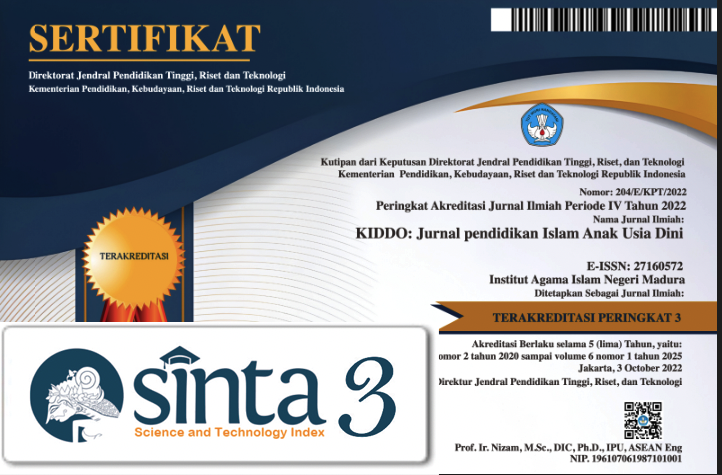Kontribusi Teori Pengondisian Klasik Terhadap Pengenalan Makharijul Huruf Hijaiyah Pada Anak Usia 5-6 Tahun
 Abstract views: 789
,
Abstract views: 789
,
 PDF downloads: 757
PDF downloads: 757
Abstract
The Classical conditioning theory discovered by Petrovich Ivan Pavlov made an extraordinary contribution to the realm of early childhood education. This theory was discovered accidentally by Pavlov while conducting experiments to determine the digestive system of dogs. This theory is known for conditioned reflexes. This theory views that learning is a change in behavior. Classical conditioning theory is usually used in early childhood education, such as changes in behavior, attitudes, ethics and habits. Furthermore, this study will see how the contribution of classical conditioning theory to the introduction of hijaiyah letters in makharijul in children aged five to six years. The objects in this study were girls ages 5-6 years whose speech was unclear. Furthermore, this research will look at the contribution of classical conditioning theory to the introduction of makharijul hijaiyah letters. This research is a type of qualitative research in the from of research (field research), with a phenomenological approach using Creswell model. The results obtained, in children aged five to six years with cedal indications, that classical conditioning theory can contribute, children can recognize and pronounce hijaiyah letters correctly.
Downloads
References
Anastasia, S. (2022). Pengondisian Klasik dan eksperimennya yang paling penting. Https://Id.Sainte-Anastasie.Org/Articles/Psicologa/El-Condicionamiento-Clsico-y-Sus-Experimentos-Ms-Importantes.Html.
Crain, W. (2014). Teori Perkembangan (Konsep dan Aplikasi) (III). In Pustaka Pelajar (III). Pustaka Pelajar.
Hamzah, A. (2020). Metode Penelitian Fenomenologi: Kajian Filsafat dan Ilmu Pengetahuan. Malang: Literasi Nusantara.
Khozin, N., & Abror, A. M. (2020). Pendampingan Pendalaman Makharij Al-Huruf bagi Santri Pondok Pesantren Hidayatul Mustaqim Bulusari Tarokan Kediri. Jurnal Pengabdian Kepada Masyarakat Desa (JPMD), 1(1), 178–188.
Laily, F. N., & Maesurah, S. (n.d.). Strategi Peningkatan Kemampuan Dan Pemahaman Siswa Tpq Atas Pelafalan Makhorijul Huruf Dan Ilmu Tajwid Di Desa Baureno, Jatirejo, Mojokerto.
Matondang, C. E. H. (2019). Analisis gangguan berbicara anak cadel (kajian pada perspektif psikologi dan neurologi). Bahastra: Jurnal Pendidikan Bahasa Dan Sastra Indonesia, 3(2), 49–59.
Nahar, N. I. (2016). Penerapan teori belajar behavioristik dalam proses pembelajaran. NUSANTARA: Jurnal Ilmu Pengetahuan Sosial, 1(1).
Pengetahuan, S., & Mahdali, F. (2020). Analisis Kemampuan Membaca Al-Qur’an Dalam Perspektif.
Putri, A. D., & Suryana, D. (2022). Teori-Teori Belajar Anak Usia Dini. Jurnal Pendidikan Tambusai, 6(2), 12486–12494.
Sudarti, D. O. (2019). Kajian teori behavioristik stimulus dan respon dalam meningkatkan minat belajar siswa. Jurnal Tarbawi, 16(2).
Sulaiman. (n.d.). Al-Qur’an Wahyu Allah Muatan Beserta Fungsinya. Https://Www.Researchgate.Net/Publication/330423153_Al-Qur%27an_Wahyu_Allah_Muatan_beserta_Fungsinya.
Suswandari, M. (2021). Peran Guru Menstimulus Respon Anak melalui Teori Belajar Behavioristik The Role of the Teacher in Stimulating Children’s Responses through Behavioristic Learning Theory. In Absorbent Mind: Journal of Psychology and Child Development Available (Vol. 1, Issue 1). https://ejournal.insuriponorogo.ac.id/index.php/absorbent_mind
Ware III, R. T. (2014). The Walking Quran: Islamic Education. Embodied Knowledge, And.
Copyright (c) 2024 Atik Wartini

This work is licensed under a Creative Commons Attribution 4.0 International License.
-
The journal operates an Open Access policy under a Creative Commons 4.0 International license. The terms of the license are:
Share— copy and redistribute the material in any medium or format
Adapt— remix, transform, and build upon the material for any purpose, even commercially.
1. Authors retain copyright and grant the journal right of first publication with the work simultaneously licensed under a Creative Commons License.that allows others to share the work with an acknowledgement of the work’s authorship and initial publication in this journal
2. Authors are permitted and encouraged to post their work online (e.g., in institutional repositories or on their website) prior to and during the submission process, as it can lead to productive exchanges, as well as earlier and greater citation of published work (See The Effect of Open Access).
Jurnal Kiddo is licensed under a Creative Commons
n Access).














